Mental Health Nursing Report: Depression and Suicide Management
VerifiedAdded on 2020/03/01
|13
|3150
|220
Report
AI Summary
This report delves into the critical aspects of mental health nursing, specifically addressing depression and suicide management within the Australian context. It begins by examining the alarming rise in suicide rates and the prevalence of depression, particularly among youth, highlighting contributing factors such as peer pressure, societal changes, and lack of support. The report analyzes the risks associated with depression, including a breakdown of causative elements, statistics related to suicide rates, and a comparison between white Australians and Aboriginal groups. It presents a case study of Jonathan, a 19-year-old struggling with depression after the loss of his mother, and explores the factors influencing his mental health. The report then outlines ethical principles essential in mental health care, such as beneficence, non-maleficence, and confidentiality, and discusses interventions for high-priority mental health risks, including risk assessment, communication strategies, and family involvement. The conclusion emphasizes the importance of addressing depression through comprehensive support and intervention strategies, underscoring the need for open communication and professional assistance.
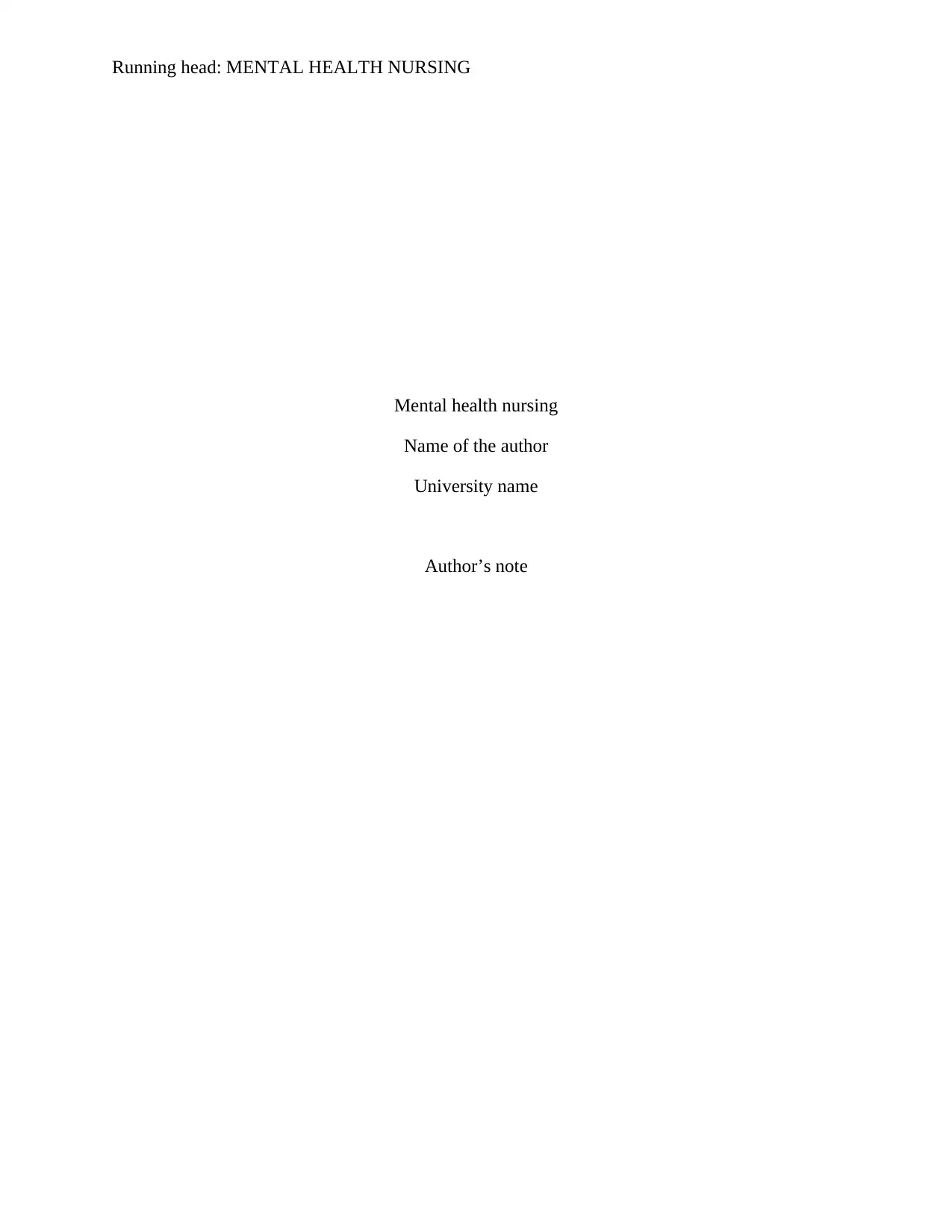
Running head: MENTAL HEALTH NURSING
Mental health nursing
Name of the author
University name
Author’s note
Mental health nursing
Name of the author
University name
Author’s note
Paraphrase This Document
Need a fresh take? Get an instant paraphrase of this document with our AI Paraphraser
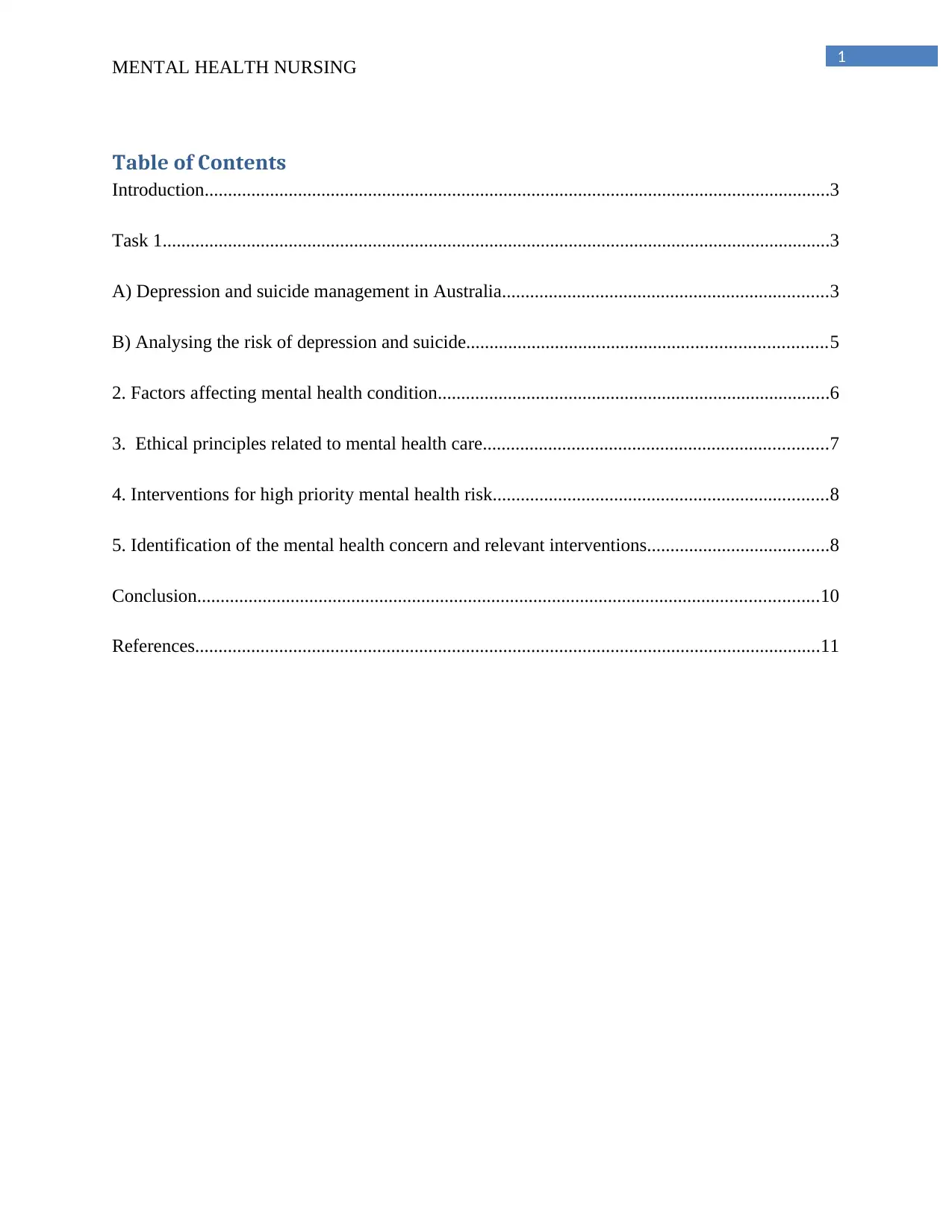
1
MENTAL HEALTH NURSING
Table of Contents
Introduction......................................................................................................................................3
Task 1...............................................................................................................................................3
A) Depression and suicide management in Australia......................................................................3
B) Analysing the risk of depression and suicide.............................................................................5
2. Factors affecting mental health condition....................................................................................6
3. Ethical principles related to mental health care..........................................................................7
4. Interventions for high priority mental health risk........................................................................8
5. Identification of the mental health concern and relevant interventions.......................................8
Conclusion.....................................................................................................................................10
References......................................................................................................................................11
MENTAL HEALTH NURSING
Table of Contents
Introduction......................................................................................................................................3
Task 1...............................................................................................................................................3
A) Depression and suicide management in Australia......................................................................3
B) Analysing the risk of depression and suicide.............................................................................5
2. Factors affecting mental health condition....................................................................................6
3. Ethical principles related to mental health care..........................................................................7
4. Interventions for high priority mental health risk........................................................................8
5. Identification of the mental health concern and relevant interventions.......................................8
Conclusion.....................................................................................................................................10
References......................................................................................................................................11
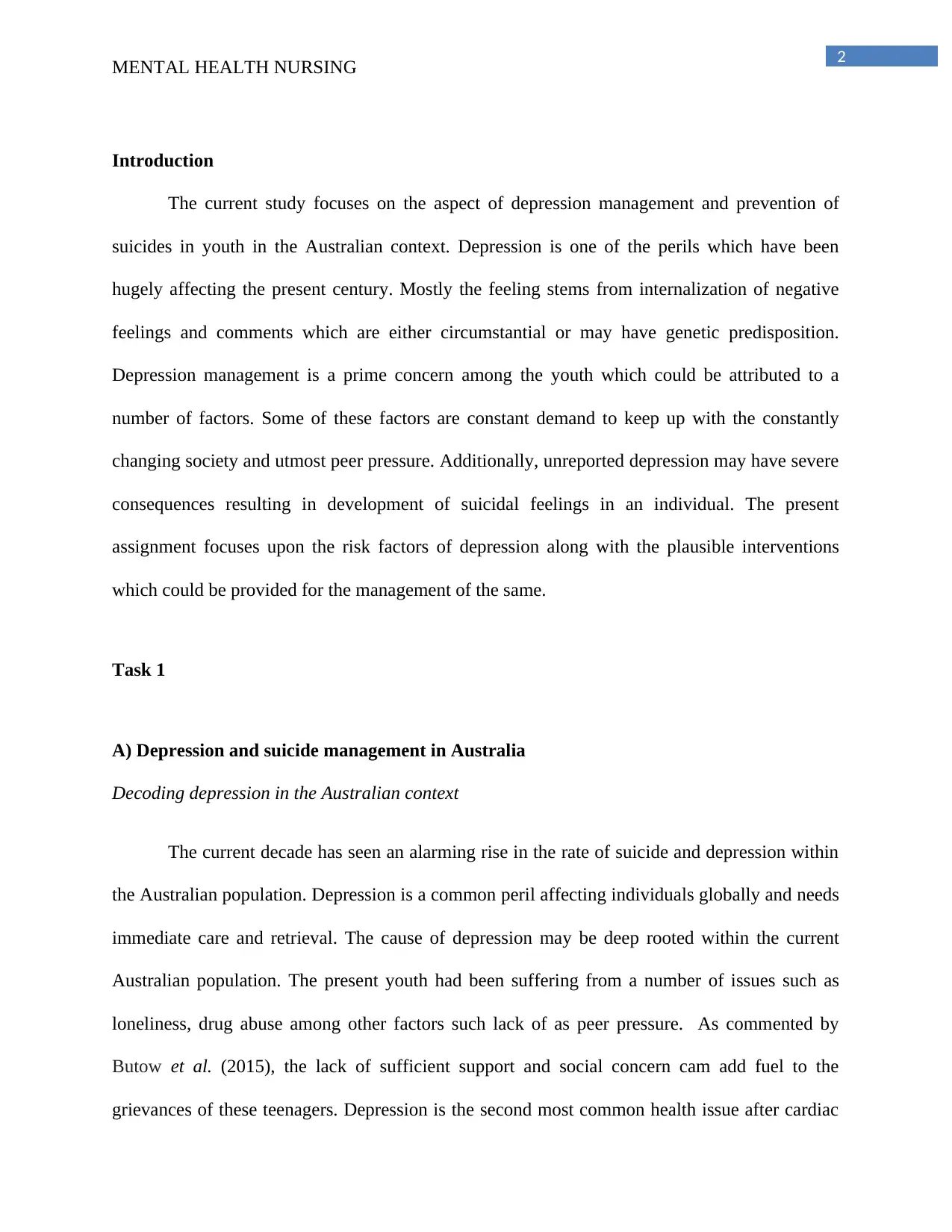
2
MENTAL HEALTH NURSING
Introduction
The current study focuses on the aspect of depression management and prevention of
suicides in youth in the Australian context. Depression is one of the perils which have been
hugely affecting the present century. Mostly the feeling stems from internalization of negative
feelings and comments which are either circumstantial or may have genetic predisposition.
Depression management is a prime concern among the youth which could be attributed to a
number of factors. Some of these factors are constant demand to keep up with the constantly
changing society and utmost peer pressure. Additionally, unreported depression may have severe
consequences resulting in development of suicidal feelings in an individual. The present
assignment focuses upon the risk factors of depression along with the plausible interventions
which could be provided for the management of the same.
Task 1
A) Depression and suicide management in Australia
Decoding depression in the Australian context
The current decade has seen an alarming rise in the rate of suicide and depression within
the Australian population. Depression is a common peril affecting individuals globally and needs
immediate care and retrieval. The cause of depression may be deep rooted within the current
Australian population. The present youth had been suffering from a number of issues such as
loneliness, drug abuse among other factors such lack of as peer pressure. As commented by
Butow et al. (2015), the lack of sufficient support and social concern cam add fuel to the
grievances of these teenagers. Depression is the second most common health issue after cardiac
MENTAL HEALTH NURSING
Introduction
The current study focuses on the aspect of depression management and prevention of
suicides in youth in the Australian context. Depression is one of the perils which have been
hugely affecting the present century. Mostly the feeling stems from internalization of negative
feelings and comments which are either circumstantial or may have genetic predisposition.
Depression management is a prime concern among the youth which could be attributed to a
number of factors. Some of these factors are constant demand to keep up with the constantly
changing society and utmost peer pressure. Additionally, unreported depression may have severe
consequences resulting in development of suicidal feelings in an individual. The present
assignment focuses upon the risk factors of depression along with the plausible interventions
which could be provided for the management of the same.
Task 1
A) Depression and suicide management in Australia
Decoding depression in the Australian context
The current decade has seen an alarming rise in the rate of suicide and depression within
the Australian population. Depression is a common peril affecting individuals globally and needs
immediate care and retrieval. The cause of depression may be deep rooted within the current
Australian population. The present youth had been suffering from a number of issues such as
loneliness, drug abuse among other factors such lack of as peer pressure. As commented by
Butow et al. (2015), the lack of sufficient support and social concern cam add fuel to the
grievances of these teenagers. Depression is the second most common health issue after cardiac
⊘ This is a preview!⊘
Do you want full access?
Subscribe today to unlock all pages.

Trusted by 1+ million students worldwide
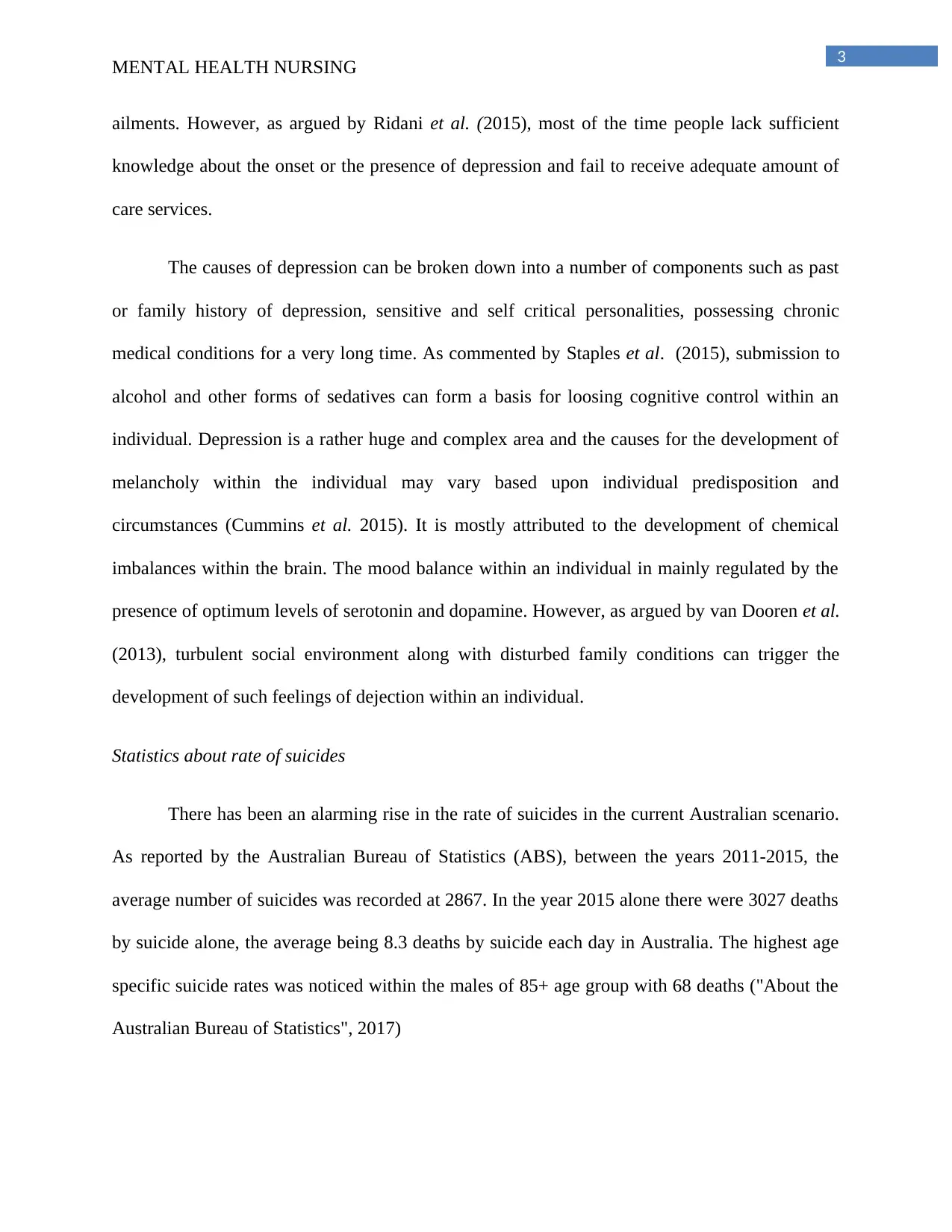
3
MENTAL HEALTH NURSING
ailments. However, as argued by Ridani et al. (2015), most of the time people lack sufficient
knowledge about the onset or the presence of depression and fail to receive adequate amount of
care services.
The causes of depression can be broken down into a number of components such as past
or family history of depression, sensitive and self critical personalities, possessing chronic
medical conditions for a very long time. As commented by Staples et al. (2015), submission to
alcohol and other forms of sedatives can form a basis for loosing cognitive control within an
individual. Depression is a rather huge and complex area and the causes for the development of
melancholy within the individual may vary based upon individual predisposition and
circumstances (Cummins et al. 2015). It is mostly attributed to the development of chemical
imbalances within the brain. The mood balance within an individual in mainly regulated by the
presence of optimum levels of serotonin and dopamine. However, as argued by van Dooren et al.
(2013), turbulent social environment along with disturbed family conditions can trigger the
development of such feelings of dejection within an individual.
Statistics about rate of suicides
There has been an alarming rise in the rate of suicides in the current Australian scenario.
As reported by the Australian Bureau of Statistics (ABS), between the years 2011-2015, the
average number of suicides was recorded at 2867. In the year 2015 alone there were 3027 deaths
by suicide alone, the average being 8.3 deaths by suicide each day in Australia. The highest age
specific suicide rates was noticed within the males of 85+ age group with 68 deaths ("About the
Australian Bureau of Statistics", 2017)
MENTAL HEALTH NURSING
ailments. However, as argued by Ridani et al. (2015), most of the time people lack sufficient
knowledge about the onset or the presence of depression and fail to receive adequate amount of
care services.
The causes of depression can be broken down into a number of components such as past
or family history of depression, sensitive and self critical personalities, possessing chronic
medical conditions for a very long time. As commented by Staples et al. (2015), submission to
alcohol and other forms of sedatives can form a basis for loosing cognitive control within an
individual. Depression is a rather huge and complex area and the causes for the development of
melancholy within the individual may vary based upon individual predisposition and
circumstances (Cummins et al. 2015). It is mostly attributed to the development of chemical
imbalances within the brain. The mood balance within an individual in mainly regulated by the
presence of optimum levels of serotonin and dopamine. However, as argued by van Dooren et al.
(2013), turbulent social environment along with disturbed family conditions can trigger the
development of such feelings of dejection within an individual.
Statistics about rate of suicides
There has been an alarming rise in the rate of suicides in the current Australian scenario.
As reported by the Australian Bureau of Statistics (ABS), between the years 2011-2015, the
average number of suicides was recorded at 2867. In the year 2015 alone there were 3027 deaths
by suicide alone, the average being 8.3 deaths by suicide each day in Australia. The highest age
specific suicide rates was noticed within the males of 85+ age group with 68 deaths ("About the
Australian Bureau of Statistics", 2017)
Paraphrase This Document
Need a fresh take? Get an instant paraphrase of this document with our AI Paraphraser
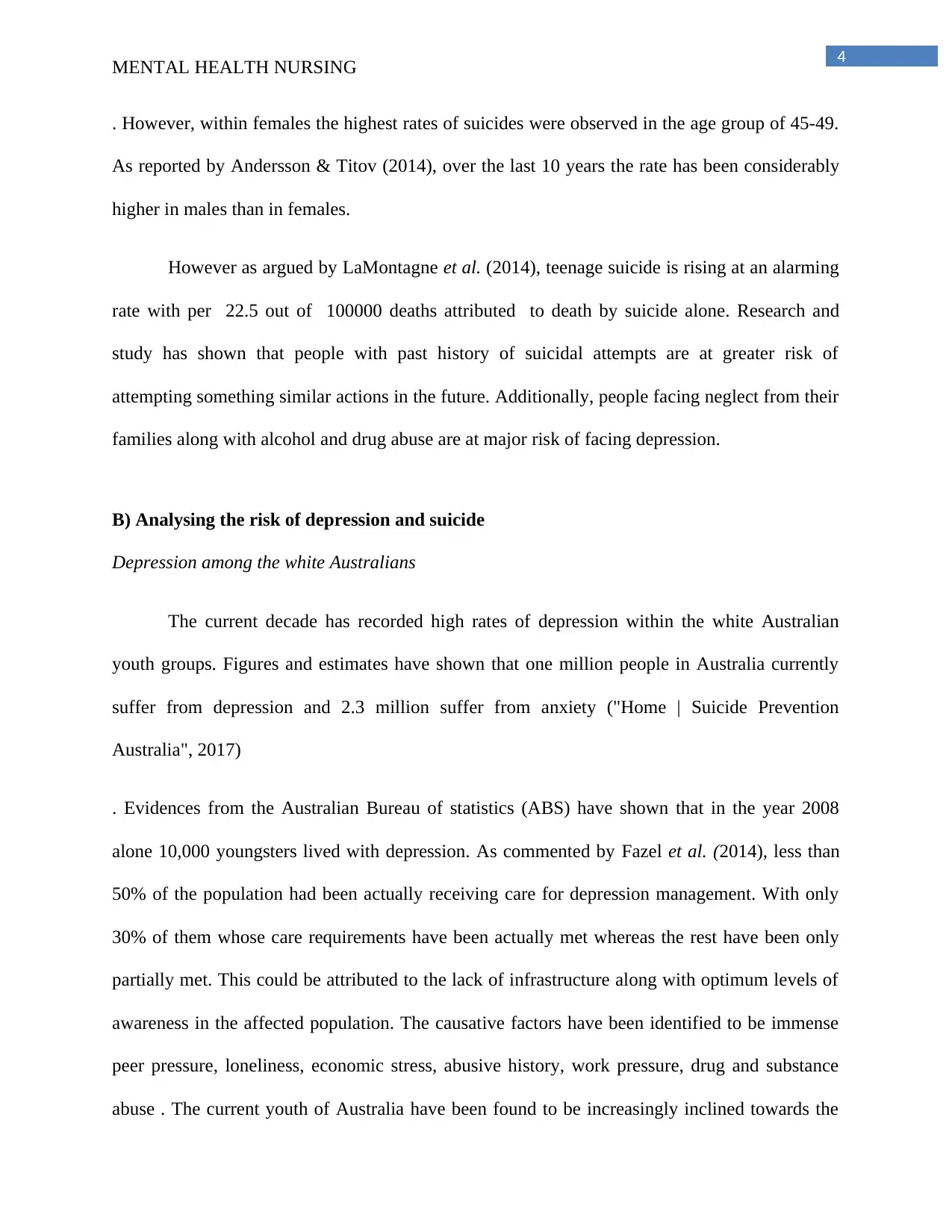
4
MENTAL HEALTH NURSING
. However, within females the highest rates of suicides were observed in the age group of 45-49.
As reported by Andersson & Titov (2014), over the last 10 years the rate has been considerably
higher in males than in females.
However as argued by LaMontagne et al. (2014), teenage suicide is rising at an alarming
rate with per 22.5 out of 100000 deaths attributed to death by suicide alone. Research and
study has shown that people with past history of suicidal attempts are at greater risk of
attempting something similar actions in the future. Additionally, people facing neglect from their
families along with alcohol and drug abuse are at major risk of facing depression.
B) Analysing the risk of depression and suicide
Depression among the white Australians
The current decade has recorded high rates of depression within the white Australian
youth groups. Figures and estimates have shown that one million people in Australia currently
suffer from depression and 2.3 million suffer from anxiety ("Home | Suicide Prevention
Australia", 2017)
. Evidences from the Australian Bureau of statistics (ABS) have shown that in the year 2008
alone 10,000 youngsters lived with depression. As commented by Fazel et al. (2014), less than
50% of the population had been actually receiving care for depression management. With only
30% of them whose care requirements have been actually met whereas the rest have been only
partially met. This could be attributed to the lack of infrastructure along with optimum levels of
awareness in the affected population. The causative factors have been identified to be immense
peer pressure, loneliness, economic stress, abusive history, work pressure, drug and substance
abuse . The current youth of Australia have been found to be increasingly inclined towards the
MENTAL HEALTH NURSING
. However, within females the highest rates of suicides were observed in the age group of 45-49.
As reported by Andersson & Titov (2014), over the last 10 years the rate has been considerably
higher in males than in females.
However as argued by LaMontagne et al. (2014), teenage suicide is rising at an alarming
rate with per 22.5 out of 100000 deaths attributed to death by suicide alone. Research and
study has shown that people with past history of suicidal attempts are at greater risk of
attempting something similar actions in the future. Additionally, people facing neglect from their
families along with alcohol and drug abuse are at major risk of facing depression.
B) Analysing the risk of depression and suicide
Depression among the white Australians
The current decade has recorded high rates of depression within the white Australian
youth groups. Figures and estimates have shown that one million people in Australia currently
suffer from depression and 2.3 million suffer from anxiety ("Home | Suicide Prevention
Australia", 2017)
. Evidences from the Australian Bureau of statistics (ABS) have shown that in the year 2008
alone 10,000 youngsters lived with depression. As commented by Fazel et al. (2014), less than
50% of the population had been actually receiving care for depression management. With only
30% of them whose care requirements have been actually met whereas the rest have been only
partially met. This could be attributed to the lack of infrastructure along with optimum levels of
awareness in the affected population. The causative factors have been identified to be immense
peer pressure, loneliness, economic stress, abusive history, work pressure, drug and substance
abuse . The current youth of Australia have been found to be increasingly inclined towards the
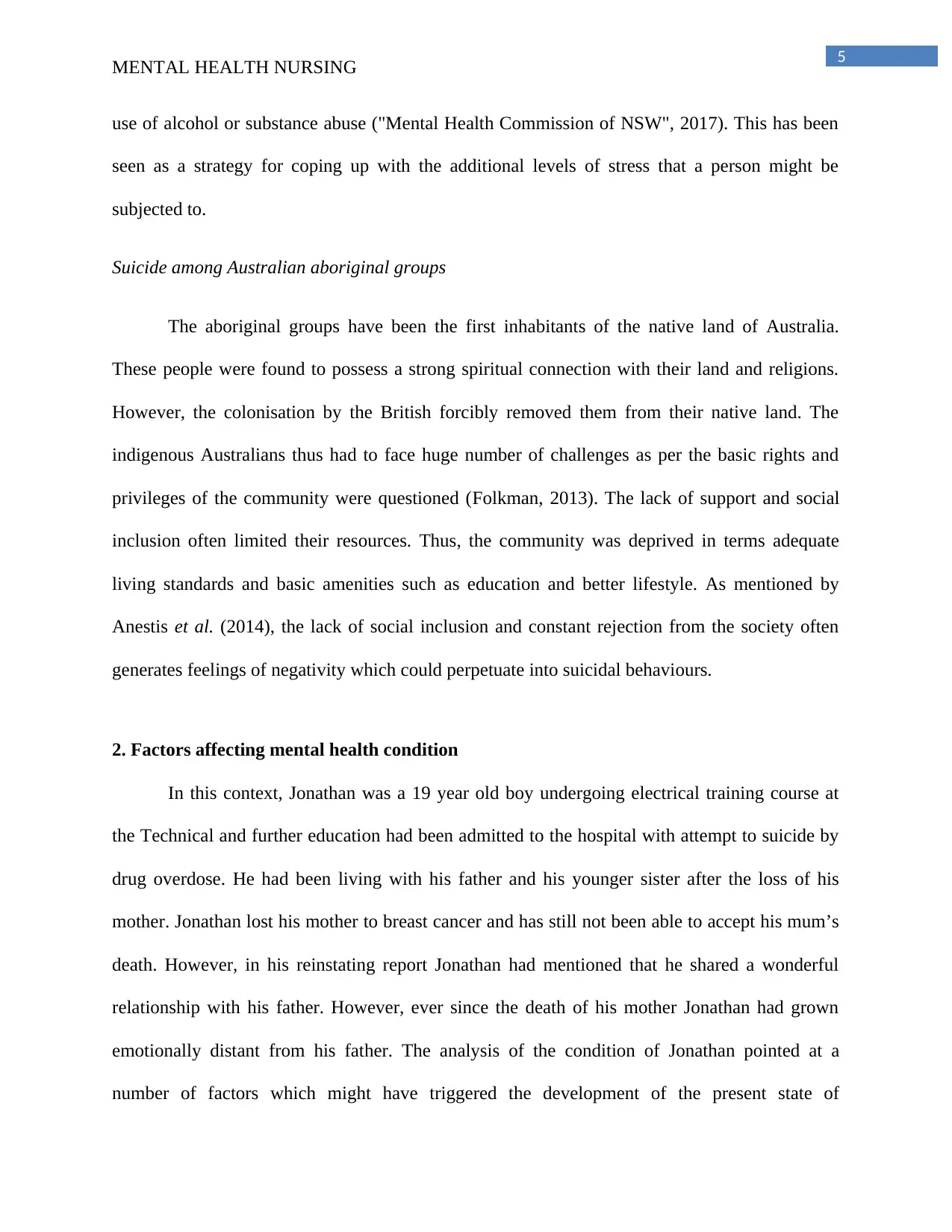
5
MENTAL HEALTH NURSING
use of alcohol or substance abuse ("Mental Health Commission of NSW", 2017). This has been
seen as a strategy for coping up with the additional levels of stress that a person might be
subjected to.
Suicide among Australian aboriginal groups
The aboriginal groups have been the first inhabitants of the native land of Australia.
These people were found to possess a strong spiritual connection with their land and religions.
However, the colonisation by the British forcibly removed them from their native land. The
indigenous Australians thus had to face huge number of challenges as per the basic rights and
privileges of the community were questioned (Folkman, 2013). The lack of support and social
inclusion often limited their resources. Thus, the community was deprived in terms adequate
living standards and basic amenities such as education and better lifestyle. As mentioned by
Anestis et al. (2014), the lack of social inclusion and constant rejection from the society often
generates feelings of negativity which could perpetuate into suicidal behaviours.
2. Factors affecting mental health condition
In this context, Jonathan was a 19 year old boy undergoing electrical training course at
the Technical and further education had been admitted to the hospital with attempt to suicide by
drug overdose. He had been living with his father and his younger sister after the loss of his
mother. Jonathan lost his mother to breast cancer and has still not been able to accept his mum’s
death. However, in his reinstating report Jonathan had mentioned that he shared a wonderful
relationship with his father. However, ever since the death of his mother Jonathan had grown
emotionally distant from his father. The analysis of the condition of Jonathan pointed at a
number of factors which might have triggered the development of the present state of
MENTAL HEALTH NURSING
use of alcohol or substance abuse ("Mental Health Commission of NSW", 2017). This has been
seen as a strategy for coping up with the additional levels of stress that a person might be
subjected to.
Suicide among Australian aboriginal groups
The aboriginal groups have been the first inhabitants of the native land of Australia.
These people were found to possess a strong spiritual connection with their land and religions.
However, the colonisation by the British forcibly removed them from their native land. The
indigenous Australians thus had to face huge number of challenges as per the basic rights and
privileges of the community were questioned (Folkman, 2013). The lack of support and social
inclusion often limited their resources. Thus, the community was deprived in terms adequate
living standards and basic amenities such as education and better lifestyle. As mentioned by
Anestis et al. (2014), the lack of social inclusion and constant rejection from the society often
generates feelings of negativity which could perpetuate into suicidal behaviours.
2. Factors affecting mental health condition
In this context, Jonathan was a 19 year old boy undergoing electrical training course at
the Technical and further education had been admitted to the hospital with attempt to suicide by
drug overdose. He had been living with his father and his younger sister after the loss of his
mother. Jonathan lost his mother to breast cancer and has still not been able to accept his mum’s
death. However, in his reinstating report Jonathan had mentioned that he shared a wonderful
relationship with his father. However, ever since the death of his mother Jonathan had grown
emotionally distant from his father. The analysis of the condition of Jonathan pointed at a
number of factors which might have triggered the development of the present state of
⊘ This is a preview!⊘
Do you want full access?
Subscribe today to unlock all pages.

Trusted by 1+ million students worldwide
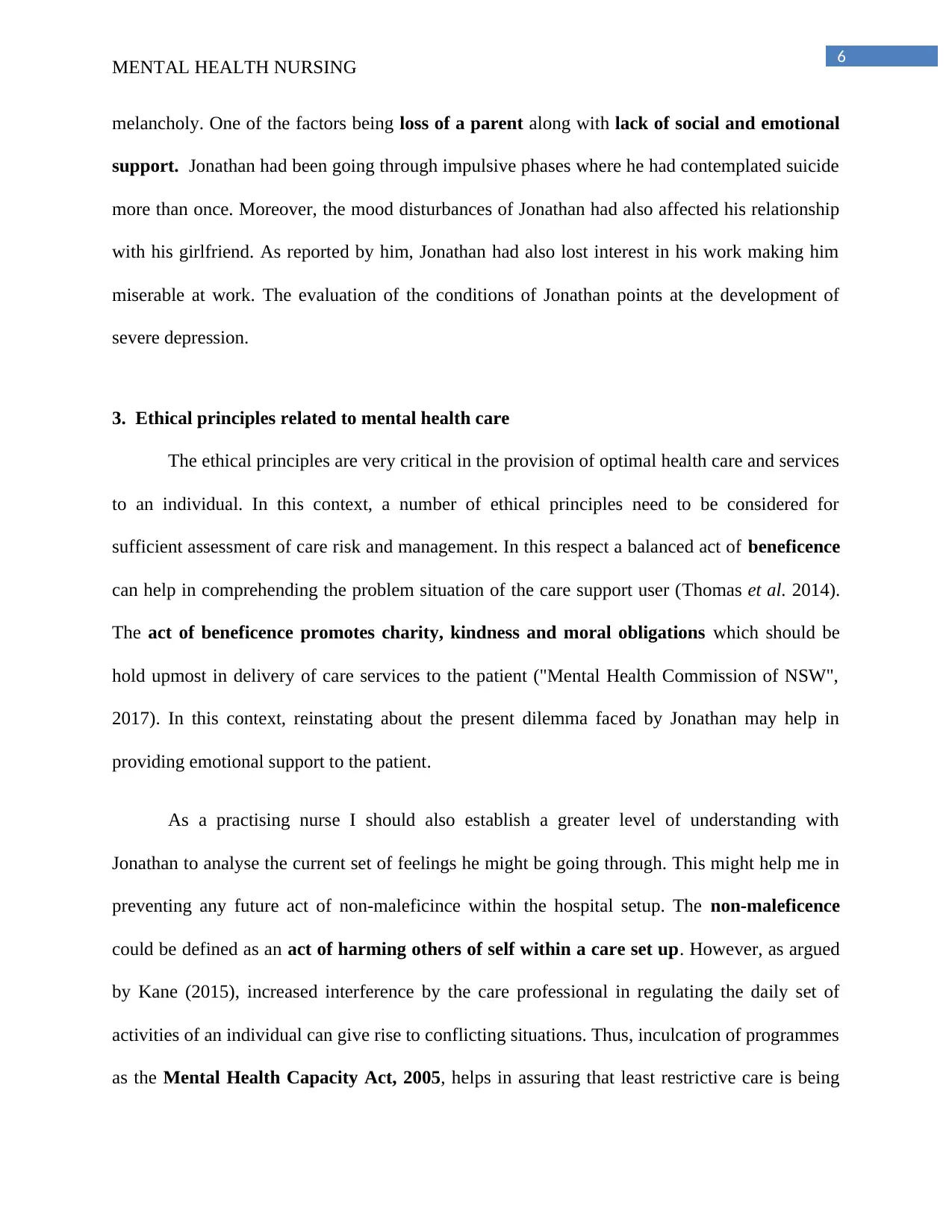
6
MENTAL HEALTH NURSING
melancholy. One of the factors being loss of a parent along with lack of social and emotional
support. Jonathan had been going through impulsive phases where he had contemplated suicide
more than once. Moreover, the mood disturbances of Jonathan had also affected his relationship
with his girlfriend. As reported by him, Jonathan had also lost interest in his work making him
miserable at work. The evaluation of the conditions of Jonathan points at the development of
severe depression.
3. Ethical principles related to mental health care
The ethical principles are very critical in the provision of optimal health care and services
to an individual. In this context, a number of ethical principles need to be considered for
sufficient assessment of care risk and management. In this respect a balanced act of beneficence
can help in comprehending the problem situation of the care support user (Thomas et al. 2014).
The act of beneficence promotes charity, kindness and moral obligations which should be
hold upmost in delivery of care services to the patient ("Mental Health Commission of NSW",
2017). In this context, reinstating about the present dilemma faced by Jonathan may help in
providing emotional support to the patient.
As a practising nurse I should also establish a greater level of understanding with
Jonathan to analyse the current set of feelings he might be going through. This might help me in
preventing any future act of non-maleficince within the hospital setup. The non-maleficence
could be defined as an act of harming others of self within a care set up. However, as argued
by Kane (2015), increased interference by the care professional in regulating the daily set of
activities of an individual can give rise to conflicting situations. Thus, inculcation of programmes
as the Mental Health Capacity Act, 2005, helps in assuring that least restrictive care is being
MENTAL HEALTH NURSING
melancholy. One of the factors being loss of a parent along with lack of social and emotional
support. Jonathan had been going through impulsive phases where he had contemplated suicide
more than once. Moreover, the mood disturbances of Jonathan had also affected his relationship
with his girlfriend. As reported by him, Jonathan had also lost interest in his work making him
miserable at work. The evaluation of the conditions of Jonathan points at the development of
severe depression.
3. Ethical principles related to mental health care
The ethical principles are very critical in the provision of optimal health care and services
to an individual. In this context, a number of ethical principles need to be considered for
sufficient assessment of care risk and management. In this respect a balanced act of beneficence
can help in comprehending the problem situation of the care support user (Thomas et al. 2014).
The act of beneficence promotes charity, kindness and moral obligations which should be
hold upmost in delivery of care services to the patient ("Mental Health Commission of NSW",
2017). In this context, reinstating about the present dilemma faced by Jonathan may help in
providing emotional support to the patient.
As a practising nurse I should also establish a greater level of understanding with
Jonathan to analyse the current set of feelings he might be going through. This might help me in
preventing any future act of non-maleficince within the hospital setup. The non-maleficence
could be defined as an act of harming others of self within a care set up. However, as argued
by Kane (2015), increased interference by the care professional in regulating the daily set of
activities of an individual can give rise to conflicting situations. Thus, inculcation of programmes
as the Mental Health Capacity Act, 2005, helps in assuring that least restrictive care is being
Paraphrase This Document
Need a fresh take? Get an instant paraphrase of this document with our AI Paraphraser
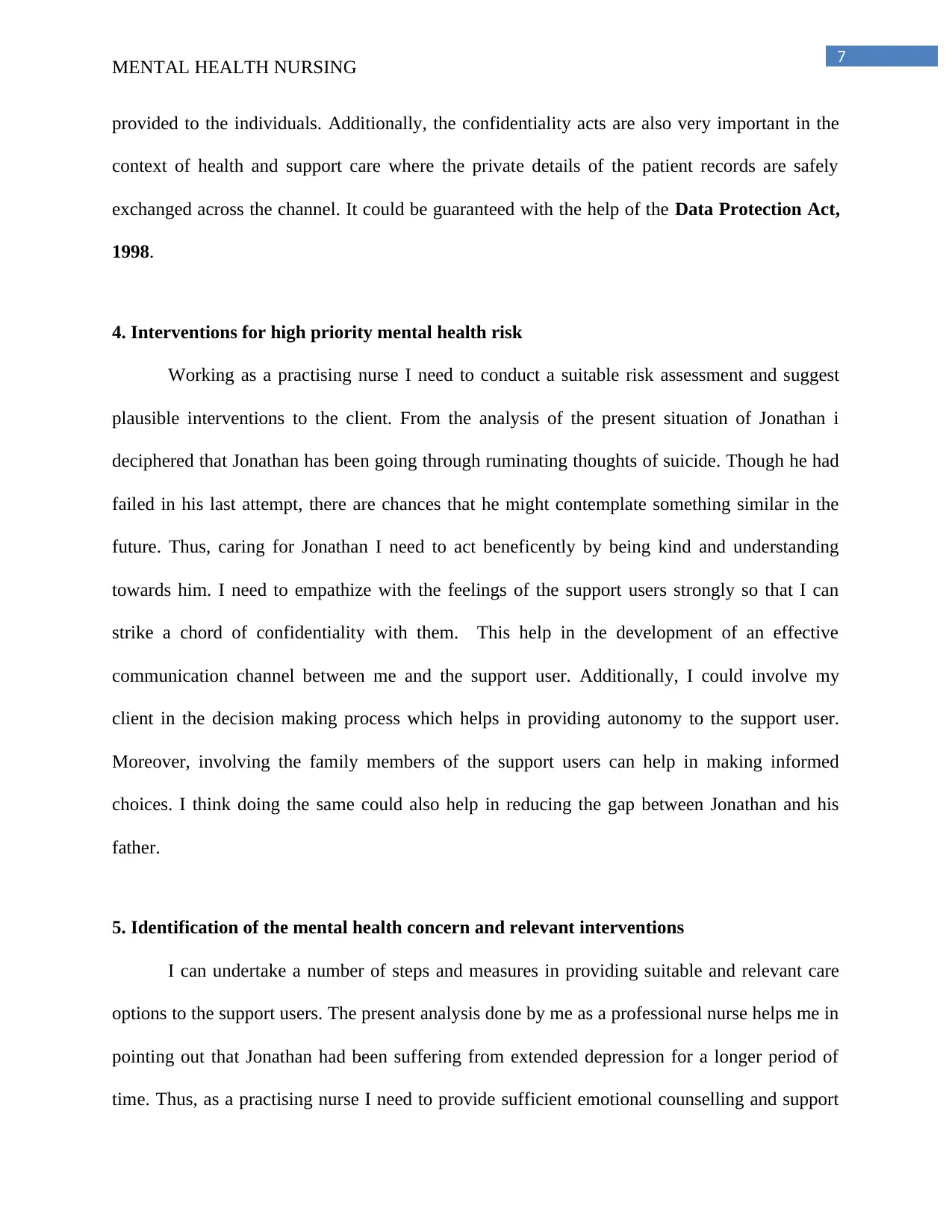
7
MENTAL HEALTH NURSING
provided to the individuals. Additionally, the confidentiality acts are also very important in the
context of health and support care where the private details of the patient records are safely
exchanged across the channel. It could be guaranteed with the help of the Data Protection Act,
1998.
4. Interventions for high priority mental health risk
Working as a practising nurse I need to conduct a suitable risk assessment and suggest
plausible interventions to the client. From the analysis of the present situation of Jonathan i
deciphered that Jonathan has been going through ruminating thoughts of suicide. Though he had
failed in his last attempt, there are chances that he might contemplate something similar in the
future. Thus, caring for Jonathan I need to act beneficently by being kind and understanding
towards him. I need to empathize with the feelings of the support users strongly so that I can
strike a chord of confidentiality with them. This help in the development of an effective
communication channel between me and the support user. Additionally, I could involve my
client in the decision making process which helps in providing autonomy to the support user.
Moreover, involving the family members of the support users can help in making informed
choices. I think doing the same could also help in reducing the gap between Jonathan and his
father.
5. Identification of the mental health concern and relevant interventions
I can undertake a number of steps and measures in providing suitable and relevant care
options to the support users. The present analysis done by me as a professional nurse helps me in
pointing out that Jonathan had been suffering from extended depression for a longer period of
time. Thus, as a practising nurse I need to provide sufficient emotional counselling and support
MENTAL HEALTH NURSING
provided to the individuals. Additionally, the confidentiality acts are also very important in the
context of health and support care where the private details of the patient records are safely
exchanged across the channel. It could be guaranteed with the help of the Data Protection Act,
1998.
4. Interventions for high priority mental health risk
Working as a practising nurse I need to conduct a suitable risk assessment and suggest
plausible interventions to the client. From the analysis of the present situation of Jonathan i
deciphered that Jonathan has been going through ruminating thoughts of suicide. Though he had
failed in his last attempt, there are chances that he might contemplate something similar in the
future. Thus, caring for Jonathan I need to act beneficently by being kind and understanding
towards him. I need to empathize with the feelings of the support users strongly so that I can
strike a chord of confidentiality with them. This help in the development of an effective
communication channel between me and the support user. Additionally, I could involve my
client in the decision making process which helps in providing autonomy to the support user.
Moreover, involving the family members of the support users can help in making informed
choices. I think doing the same could also help in reducing the gap between Jonathan and his
father.
5. Identification of the mental health concern and relevant interventions
I can undertake a number of steps and measures in providing suitable and relevant care
options to the support users. The present analysis done by me as a professional nurse helps me in
pointing out that Jonathan had been suffering from extended depression for a longer period of
time. Thus, as a practising nurse I need to provide sufficient emotional counselling and support
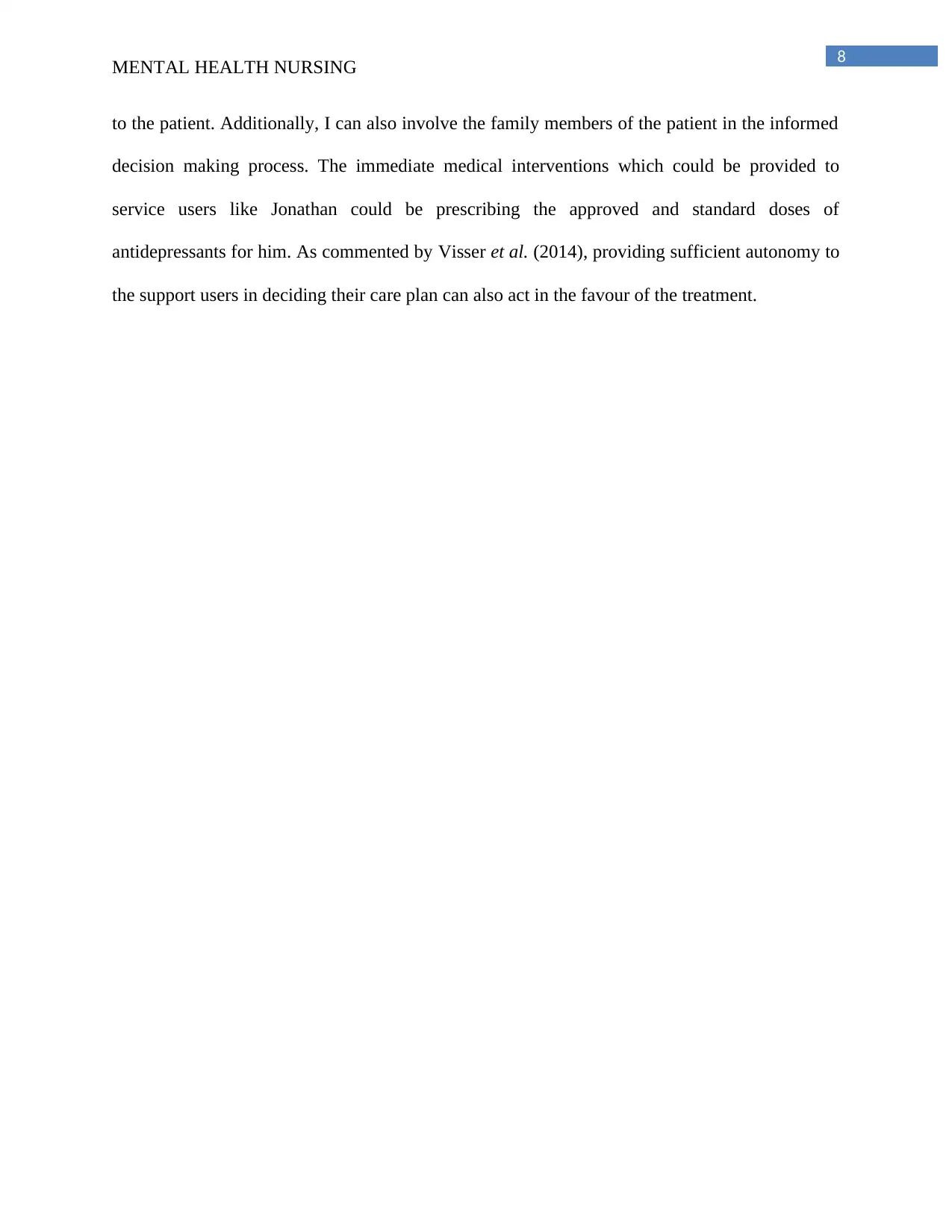
8
MENTAL HEALTH NURSING
to the patient. Additionally, I can also involve the family members of the patient in the informed
decision making process. The immediate medical interventions which could be provided to
service users like Jonathan could be prescribing the approved and standard doses of
antidepressants for him. As commented by Visser et al. (2014), providing sufficient autonomy to
the support users in deciding their care plan can also act in the favour of the treatment.
MENTAL HEALTH NURSING
to the patient. Additionally, I can also involve the family members of the patient in the informed
decision making process. The immediate medical interventions which could be provided to
service users like Jonathan could be prescribing the approved and standard doses of
antidepressants for him. As commented by Visser et al. (2014), providing sufficient autonomy to
the support users in deciding their care plan can also act in the favour of the treatment.
⊘ This is a preview!⊘
Do you want full access?
Subscribe today to unlock all pages.

Trusted by 1+ million students worldwide
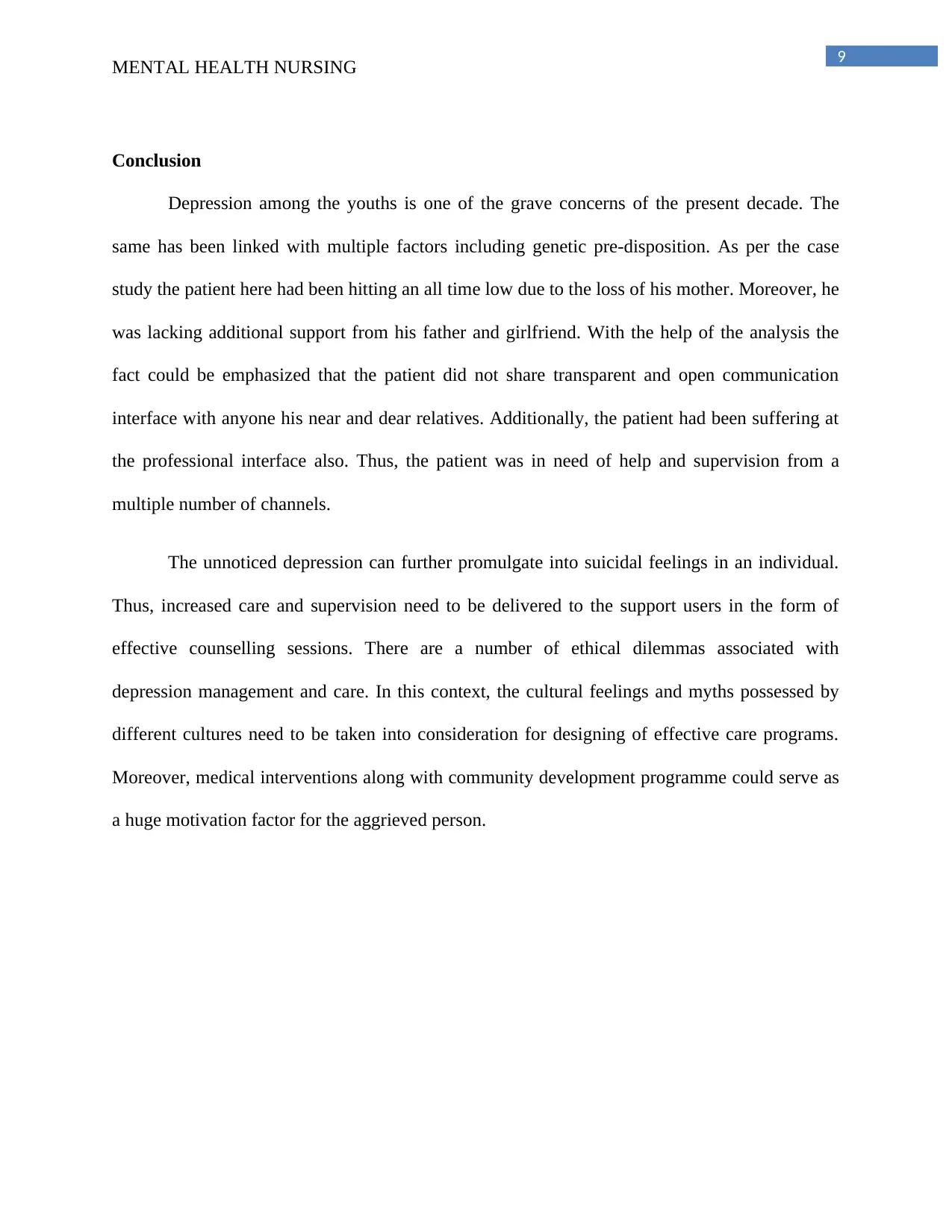
9
MENTAL HEALTH NURSING
Conclusion
Depression among the youths is one of the grave concerns of the present decade. The
same has been linked with multiple factors including genetic pre-disposition. As per the case
study the patient here had been hitting an all time low due to the loss of his mother. Moreover, he
was lacking additional support from his father and girlfriend. With the help of the analysis the
fact could be emphasized that the patient did not share transparent and open communication
interface with anyone his near and dear relatives. Additionally, the patient had been suffering at
the professional interface also. Thus, the patient was in need of help and supervision from a
multiple number of channels.
The unnoticed depression can further promulgate into suicidal feelings in an individual.
Thus, increased care and supervision need to be delivered to the support users in the form of
effective counselling sessions. There are a number of ethical dilemmas associated with
depression management and care. In this context, the cultural feelings and myths possessed by
different cultures need to be taken into consideration for designing of effective care programs.
Moreover, medical interventions along with community development programme could serve as
a huge motivation factor for the aggrieved person.
MENTAL HEALTH NURSING
Conclusion
Depression among the youths is one of the grave concerns of the present decade. The
same has been linked with multiple factors including genetic pre-disposition. As per the case
study the patient here had been hitting an all time low due to the loss of his mother. Moreover, he
was lacking additional support from his father and girlfriend. With the help of the analysis the
fact could be emphasized that the patient did not share transparent and open communication
interface with anyone his near and dear relatives. Additionally, the patient had been suffering at
the professional interface also. Thus, the patient was in need of help and supervision from a
multiple number of channels.
The unnoticed depression can further promulgate into suicidal feelings in an individual.
Thus, increased care and supervision need to be delivered to the support users in the form of
effective counselling sessions. There are a number of ethical dilemmas associated with
depression management and care. In this context, the cultural feelings and myths possessed by
different cultures need to be taken into consideration for designing of effective care programs.
Moreover, medical interventions along with community development programme could serve as
a huge motivation factor for the aggrieved person.
Paraphrase This Document
Need a fresh take? Get an instant paraphrase of this document with our AI Paraphraser
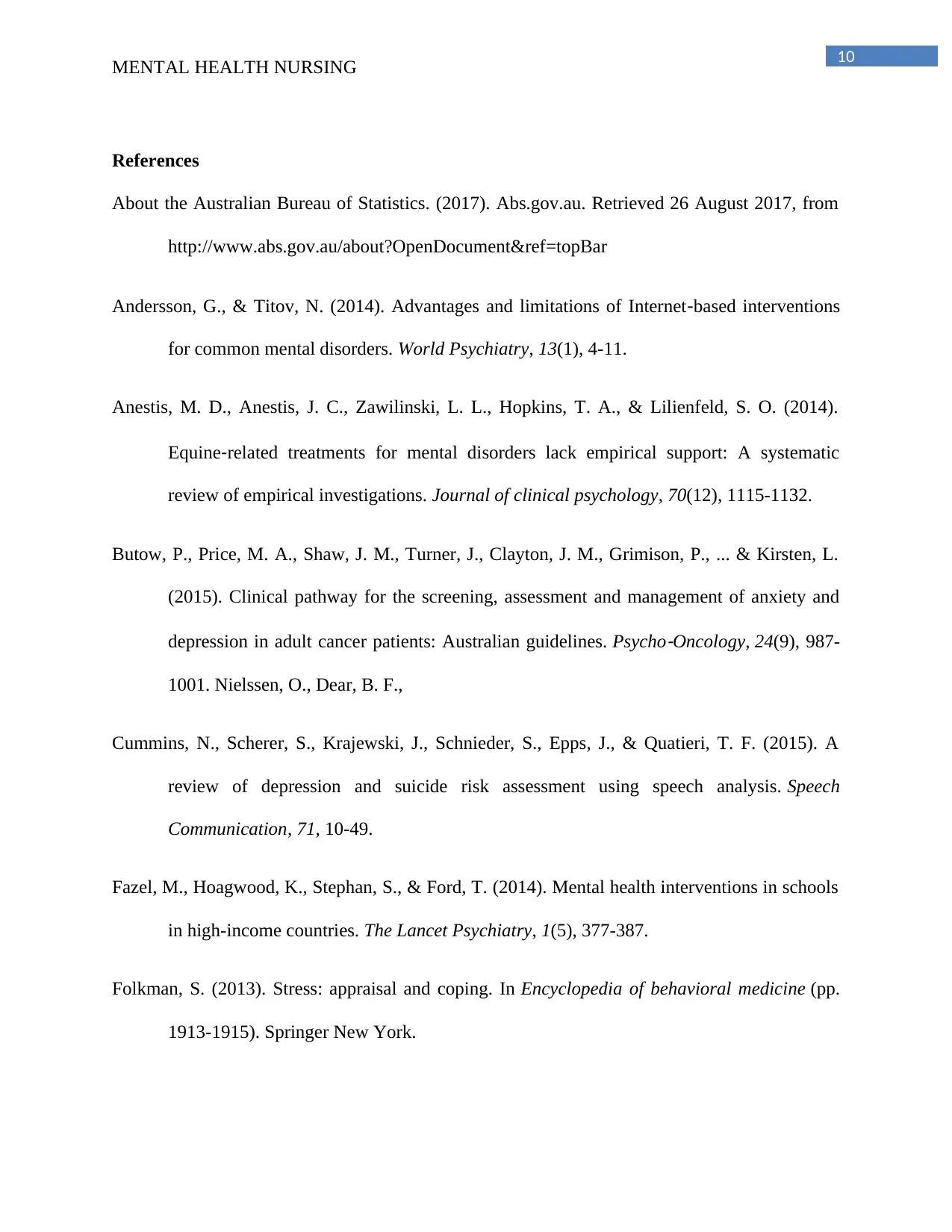
10
MENTAL HEALTH NURSING
References
About the Australian Bureau of Statistics. (2017). Abs.gov.au. Retrieved 26 August 2017, from
http://www.abs.gov.au/about?OpenDocument&ref=topBar
Andersson, G., & Titov, N. (2014). Advantages and limitations of Internet‐based interventions
for common mental disorders. World Psychiatry, 13(1), 4-11.
Anestis, M. D., Anestis, J. C., Zawilinski, L. L., Hopkins, T. A., & Lilienfeld, S. O. (2014).
Equine‐related treatments for mental disorders lack empirical support: A systematic
review of empirical investigations. Journal of clinical psychology, 70(12), 1115-1132.
Butow, P., Price, M. A., Shaw, J. M., Turner, J., Clayton, J. M., Grimison, P., ... & Kirsten, L.
(2015). Clinical pathway for the screening, assessment and management of anxiety and
depression in adult cancer patients: Australian guidelines. Psycho
‐Oncology, 24(9), 987-
1001. Nielssen, O., Dear, B. F.,
Cummins, N., Scherer, S., Krajewski, J., Schnieder, S., Epps, J., & Quatieri, T. F. (2015). A
review of depression and suicide risk assessment using speech analysis. Speech
Communication, 71, 10-49.
Fazel, M., Hoagwood, K., Stephan, S., & Ford, T. (2014). Mental health interventions in schools
in high-income countries. The Lancet Psychiatry, 1(5), 377-387.
Folkman, S. (2013). Stress: appraisal and coping. In Encyclopedia of behavioral medicine (pp.
1913-1915). Springer New York.
MENTAL HEALTH NURSING
References
About the Australian Bureau of Statistics. (2017). Abs.gov.au. Retrieved 26 August 2017, from
http://www.abs.gov.au/about?OpenDocument&ref=topBar
Andersson, G., & Titov, N. (2014). Advantages and limitations of Internet‐based interventions
for common mental disorders. World Psychiatry, 13(1), 4-11.
Anestis, M. D., Anestis, J. C., Zawilinski, L. L., Hopkins, T. A., & Lilienfeld, S. O. (2014).
Equine‐related treatments for mental disorders lack empirical support: A systematic
review of empirical investigations. Journal of clinical psychology, 70(12), 1115-1132.
Butow, P., Price, M. A., Shaw, J. M., Turner, J., Clayton, J. M., Grimison, P., ... & Kirsten, L.
(2015). Clinical pathway for the screening, assessment and management of anxiety and
depression in adult cancer patients: Australian guidelines. Psycho
‐Oncology, 24(9), 987-
1001. Nielssen, O., Dear, B. F.,
Cummins, N., Scherer, S., Krajewski, J., Schnieder, S., Epps, J., & Quatieri, T. F. (2015). A
review of depression and suicide risk assessment using speech analysis. Speech
Communication, 71, 10-49.
Fazel, M., Hoagwood, K., Stephan, S., & Ford, T. (2014). Mental health interventions in schools
in high-income countries. The Lancet Psychiatry, 1(5), 377-387.
Folkman, S. (2013). Stress: appraisal and coping. In Encyclopedia of behavioral medicine (pp.
1913-1915). Springer New York.
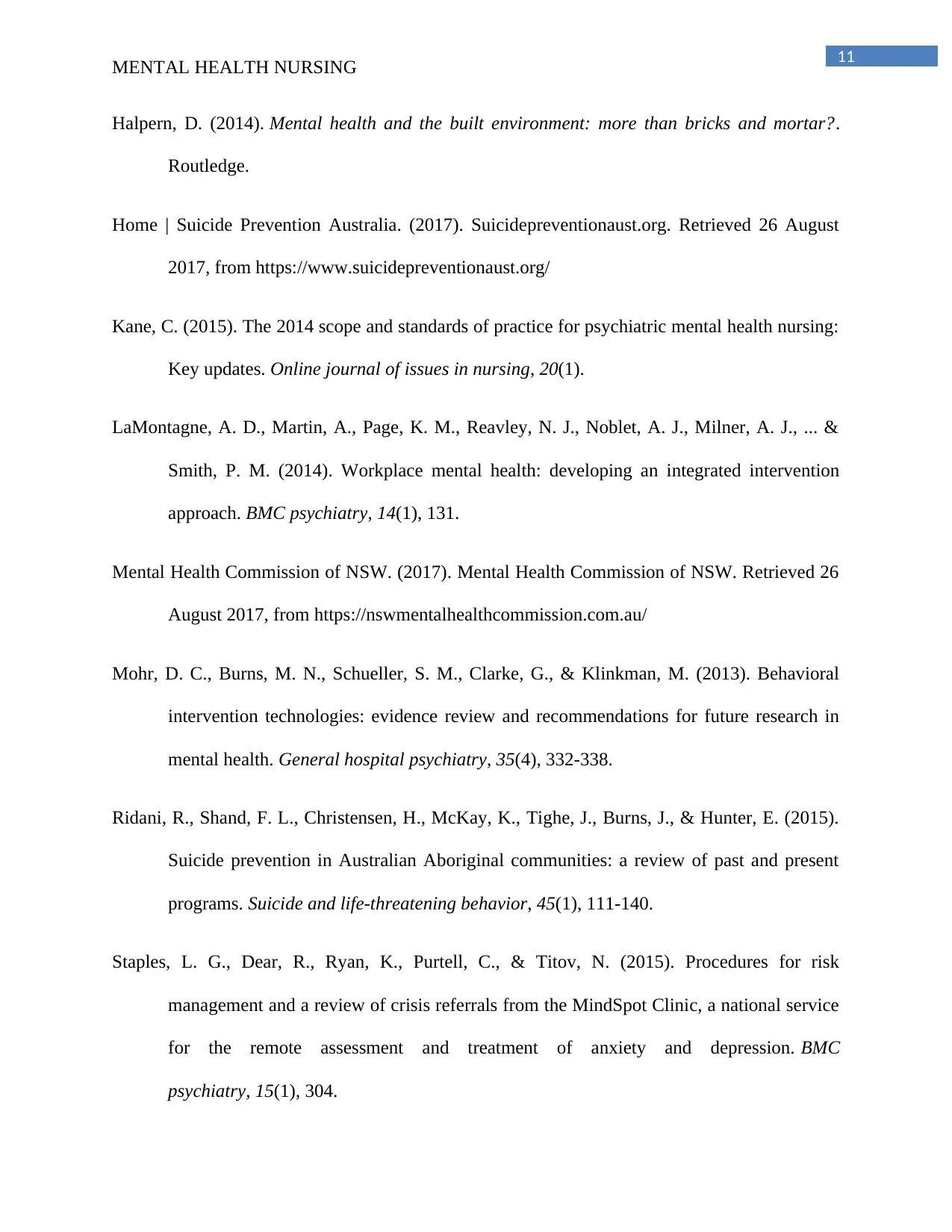
11
MENTAL HEALTH NURSING
Halpern, D. (2014). Mental health and the built environment: more than bricks and mortar?.
Routledge.
Home | Suicide Prevention Australia. (2017). Suicidepreventionaust.org. Retrieved 26 August
2017, from https://www.suicidepreventionaust.org/
Kane, C. (2015). The 2014 scope and standards of practice for psychiatric mental health nursing:
Key updates. Online journal of issues in nursing, 20(1).
LaMontagne, A. D., Martin, A., Page, K. M., Reavley, N. J., Noblet, A. J., Milner, A. J., ... &
Smith, P. M. (2014). Workplace mental health: developing an integrated intervention
approach. BMC psychiatry, 14(1), 131.
Mental Health Commission of NSW. (2017). Mental Health Commission of NSW. Retrieved 26
August 2017, from https://nswmentalhealthcommission.com.au/
Mohr, D. C., Burns, M. N., Schueller, S. M., Clarke, G., & Klinkman, M. (2013). Behavioral
intervention technologies: evidence review and recommendations for future research in
mental health. General hospital psychiatry, 35(4), 332-338.
Ridani, R., Shand, F. L., Christensen, H., McKay, K., Tighe, J., Burns, J., & Hunter, E. (2015).
Suicide prevention in Australian Aboriginal communities: a review of past and present
programs. Suicide and life-threatening behavior, 45(1), 111-140.
Staples, L. G., Dear, R., Ryan, K., Purtell, C., & Titov, N. (2015). Procedures for risk
management and a review of crisis referrals from the MindSpot Clinic, a national service
for the remote assessment and treatment of anxiety and depression. BMC
psychiatry, 15(1), 304.
MENTAL HEALTH NURSING
Halpern, D. (2014). Mental health and the built environment: more than bricks and mortar?.
Routledge.
Home | Suicide Prevention Australia. (2017). Suicidepreventionaust.org. Retrieved 26 August
2017, from https://www.suicidepreventionaust.org/
Kane, C. (2015). The 2014 scope and standards of practice for psychiatric mental health nursing:
Key updates. Online journal of issues in nursing, 20(1).
LaMontagne, A. D., Martin, A., Page, K. M., Reavley, N. J., Noblet, A. J., Milner, A. J., ... &
Smith, P. M. (2014). Workplace mental health: developing an integrated intervention
approach. BMC psychiatry, 14(1), 131.
Mental Health Commission of NSW. (2017). Mental Health Commission of NSW. Retrieved 26
August 2017, from https://nswmentalhealthcommission.com.au/
Mohr, D. C., Burns, M. N., Schueller, S. M., Clarke, G., & Klinkman, M. (2013). Behavioral
intervention technologies: evidence review and recommendations for future research in
mental health. General hospital psychiatry, 35(4), 332-338.
Ridani, R., Shand, F. L., Christensen, H., McKay, K., Tighe, J., Burns, J., & Hunter, E. (2015).
Suicide prevention in Australian Aboriginal communities: a review of past and present
programs. Suicide and life-threatening behavior, 45(1), 111-140.
Staples, L. G., Dear, R., Ryan, K., Purtell, C., & Titov, N. (2015). Procedures for risk
management and a review of crisis referrals from the MindSpot Clinic, a national service
for the remote assessment and treatment of anxiety and depression. BMC
psychiatry, 15(1), 304.
⊘ This is a preview!⊘
Do you want full access?
Subscribe today to unlock all pages.

Trusted by 1+ million students worldwide
1 out of 13
Related Documents
Your All-in-One AI-Powered Toolkit for Academic Success.
+13062052269
info@desklib.com
Available 24*7 on WhatsApp / Email
![[object Object]](/_next/static/media/star-bottom.7253800d.svg)
Unlock your academic potential
Copyright © 2020–2025 A2Z Services. All Rights Reserved. Developed and managed by ZUCOL.





